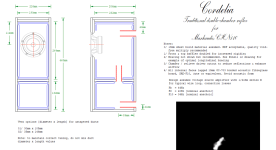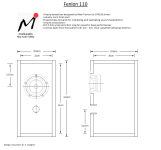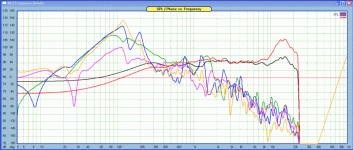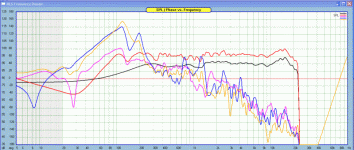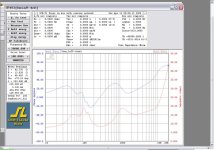Looking at this 2 cabinets for Mark Audio CHN 110 I am in doubt:
They seem to have more or less the same volume, and what is the advantage over the DCR Dual chamber bass reflex cabinet over the normal bass reflex?
Updated: I found the Double Chamber Reflex (DCR) article on Electronics World by G.L. Augspurger / December 1961 and attach bellow too for who may be interested.
They seem to have more or less the same volume, and what is the advantage over the DCR Dual chamber bass reflex cabinet over the normal bass reflex?
Updated: I found the Double Chamber Reflex (DCR) article on Electronics World by G.L. Augspurger / December 1961 and attach bellow too for who may be interested.
Attachments
Last edited:
If you like towers / mini towers
Is a fun way to make things taller
and be able to do so and use the extra volume.
Technically you should be able to reach the same
-3dB low frequency response as a normal reflex.
But the first chamber can usually be made smaller.
So cone excursion/ power handling can be
increased depending on application.
So with normal reflex the smaller volume
would do the same, improve power handling.
But the -3 dB response likely higher.
Another interesting thing is, for some reason
you wanted a very low tuning in a small box.
Port length with a round tube can get too long.
With dual chamber the port lengths are relatively
short but tuning can be much lower with shorter tubes.
So efficiency is rather poor and velocity usually high
to squeeze in a junk slot port tuned low in a small
box. Dual chamber you can reduce velocity and use
nice flared round ports for better efficiency. And still
fit them in the box.
Is a fun way to make things taller
and be able to do so and use the extra volume.
Technically you should be able to reach the same
-3dB low frequency response as a normal reflex.
But the first chamber can usually be made smaller.
So cone excursion/ power handling can be
increased depending on application.
So with normal reflex the smaller volume
would do the same, improve power handling.
But the -3 dB response likely higher.
Another interesting thing is, for some reason
you wanted a very low tuning in a small box.
Port length with a round tube can get too long.
With dual chamber the port lengths are relatively
short but tuning can be much lower with shorter tubes.
So efficiency is rather poor and velocity usually high
to squeeze in a junk slot port tuned low in a small
box. Dual chamber you can reduce velocity and use
nice flared round ports for better efficiency. And still
fit them in the box.
Different type of box -you're thinking of the Double Bass Reflex, rather than the Double Chamber Reflex (which is what the Cordelia enclose above, which I designed for CHN-110, is). DBRs have a small driver-chamber venting into a larger chamber that is itself vented to the room. DCRs run the driver in the larger upper volume, which is vented to both the external room and internally into a smaller lower chamber, which is also vented to the external room.But the first chamber can usually be made smaller.
I rarely design the Fostex / Nagaoka style of DBR, where in essence the theory is to decouple the smaller upper driver volume from the lower 'bass chamber' at higher frequencies as I never found it worked too well, although I do sometimes design my own variation on the internally cascaded multi-chamber theme. DCRs like Codelia can be useful in that they have two more functional tuning frequencies: the sum of both volumes, tuned as you would expect for the summed vent dimensions, and a secondary, higher tuning (from the upper volume alone). Since a lot of modern music in particular has the majority of its power-band in the ~60Hz - 120Hz region, this means that a fairly typical single-chamber vented box, tuned somewhere in the 40Hz - 50Hz bandwidth, hits its point of maximum passband excursion right in the middle of that zone. Since the DCR has that second tuning roughly an octave above the nominal Fb, excursion drops & you've got more headroom (dynamic range) as a result. The downside is, they do have a minor cancellation in their response, but assuming its well designed, this is usually only about 2dB and typically swamped out by room effects. I quite like them.
Not for any properly designed DCR that I've ever seen.With dual chamber the port lengths are relatively
short but tuning can be much lower with shorter tubes.
 Because you have multiple ducts, the overall length is actually longer than if you used a single vent of the same CSA in the same total Vb and Fb. That is, or can be, one of the challenges when designing them, as you need to ensure a/ length doesn't become excessive, and b/ the damn things fit. 😉
Because you have multiple ducts, the overall length is actually longer than if you used a single vent of the same CSA in the same total Vb and Fb. That is, or can be, one of the challenges when designing them, as you need to ensure a/ length doesn't become excessive, and b/ the damn things fit. 😉
Last edited:
I built a D.C.R. a few years ago using the W5-2143 Tang Band driver and I thought it sounded better, (cleaner for lack of a better term) than the typical reflex box. Also, I think the ~70 - 100 Hz region may have been slightly emphasized or maybe "unmasked" giving a more full sound. It's not much more effort than the usual reflex box. If you go to http://www.claudionegro.com and then the projects directory then speakers directory you will see a project (Auri) which then leads to the D.C.R. page which explains the theory and practice.
Interestingly, Scott's design has both ports exiting out the rear while Claudio's exit out the front. I wonder which is optimum. It probably depends on room placement...
I also wonder if there are any designs for the 4" drivers from Markaudio or Fostex, especially after reading Michael Chua's experiments with the CHP-70.
Scott?
I also wonder if there are any designs for the 4" drivers from Markaudio or Fostex, especially after reading Michael Chua's experiments with the CHP-70.
Scott?
There's no single optimum as such; it depends on the design and the balance of compromises the designer decides to follow. For relatively small ducted vent boxes with a low tuning frequency for size, I usually prefer rear vent locations. It's often easier to fit them at a preferable longitudinal that isn't available for space reasons on the front baffle, and if you've had to compromise on duct CSA to keep length down & avoid audible resonant modes (ducts being 1/2 wave resonators), you can within reason keep any minor flow-noise due to the slightly increased velocity inaudible. Since I tend to target moderately well-damped alignments, you can position within a few inches of a wall; unless you're ramming the speaker right up against a boundary / corner / cavity, excess LF gain around tuning is more likely to be caused by a flat or underdamped alignment than the vent position / postions per se. That's just for acoustically small speakers though (as in speakers that are tuned low for a modest Vb). With others, I might & often do choose differently.
Yes, I've done a few DCRs for the 4in Markaudio units & others; they're mostly part of a set of paid-plansets that got stuck in the ever-growing 'to do / complete' pile a while back. 😉
Yes, I've done a few DCRs for the 4in Markaudio units & others; they're mostly part of a set of paid-plansets that got stuck in the ever-growing 'to do / complete' pile a while back. 😉
I've always used the terms DCR and DBR interchangeably. As drawn, one is just nested/cascaded or series-tuned without a first chamber exit.
I've gone so far as building a 3CR, and used 5 ports in the cabinet.
I'm currently working on what this thread is labeling a DBR using PRs.
Jurgen Micka's website will model the boxes...
https://www.micka.de/en/advanced.php#
I've gone so far as building a 3CR, and used 5 ports in the cabinet.
I'm currently working on what this thread is labeling a DBR using PRs.
Jurgen Micka's website will model the boxes...
https://www.micka.de/en/advanced.php#
what was the driver / total volume & how did you proportion the 3CR' chambers? Did it result in a more "articulate" upper bass presentation than a simple reflex box ? What were your goals ?
Being that the original instructions for DCR dictated a 1/3 to 2/3 volume arrangement, and 3 equal ports; I used a 1/2 volume and 2 volumes of 1/4 the total, and the total was i think 9 ltrs. To get a lower tuning with someting like this is just really not possible, and i think the center tuning was supposed to be 65-70Hz range. I built these back in 2007. The main reason for this was to see if there were benefits to more strung chambers and further spreading out the tunings to reduce xmax on the 4.5" W4-1337 driver I was using. I also could not make the 3rd chamber smaller and install the ports as needed being 1.5" pvc or metal sink drop-tubes. I placed the length of the 1-2 transition port in the 1st chamber, and the 2-3 transition port into the 3rd chamber with a elbow. This is to maybe decrease the 3rd volume enough by comparison to the 2nd chamber to offset the tunings that much further. On the front, the ports resemble an A without the central cross-member. Upper half is main 1st, and lower half is 2 and 3 side by side. It worked much better with the 1337 than the FR125S I first tried, however, plugging the first exterior port from the first chamber made the FR125S sound quite good as well as it lowered the Q of the volume.
I tried to have the port outputs' FR measured at the time, but that was harder to do than thought being 3 exterior ports. I couldn't isolate them well enough. Going back to revisit this later when I disovered Jurgen's website, I did some modeling and discovered it is very hard to do a 3CR without getting a substantial peak in the response. Though, I have my doubts that I did the modeling at that time correctly, as I've become more familiar with the website since then.
Suffice to say, the design was stout on bass response, and I likely did not need full BSC using this kind of bass alignment. I did notice though that the driver does not move much, even at higher outputs. I call that a win. Thick or warm bass maybe, but not boomy.
This is all kinda interesting, as fairly recently I announced the theme for next year's InDIYana event to be "Inner Sanctum", and revolves around multichamber usages for woofer alignments. It also spurred the DBR with PRs as I'm building currently. It also has spurred at least 2-3 other people building DCR alignments, with a PR for the first exterior tuning to eliminate the port resonance in the passband. The reports of the 1st to be heard in public are favorable, but fine tuning adjustment was required at the early stage.
I tried to have the port outputs' FR measured at the time, but that was harder to do than thought being 3 exterior ports. I couldn't isolate them well enough. Going back to revisit this later when I disovered Jurgen's website, I did some modeling and discovered it is very hard to do a 3CR without getting a substantial peak in the response. Though, I have my doubts that I did the modeling at that time correctly, as I've become more familiar with the website since then.
Suffice to say, the design was stout on bass response, and I likely did not need full BSC using this kind of bass alignment. I did notice though that the driver does not move much, even at higher outputs. I call that a win. Thick or warm bass maybe, but not boomy.
This is all kinda interesting, as fairly recently I announced the theme for next year's InDIYana event to be "Inner Sanctum", and revolves around multichamber usages for woofer alignments. It also spurred the DBR with PRs as I'm building currently. It also has spurred at least 2-3 other people building DCR alignments, with a PR for the first exterior tuning to eliminate the port resonance in the passband. The reports of the 1st to be heard in public are favorable, but fine tuning adjustment was required at the early stage.
by 5 ports - does that mean 3 external ports (one for each chamber) plus two interconnecting internal ports ? I'd like to try this with a 10 or 12 inch speaker to keep size reasonable. Could it cascade successfully into a Karlson's front chamber? (might be a lot of fidgeting !)
Does hornresp offer a straightforwards approach to simulate the 3-chamber bass reflex box ?
Does hornresp offer a straightforwards approach to simulate the 3-chamber bass reflex box ?
https://projectgallery.parts-express.com/speaker-projects/3cr-ti/
PE still has the writeup active from 2007, so here you go!
PE still has the writeup active from 2007, so here you go!
I'm confused as to properly setting / identifying chambers-ports with Micka's simulator for the 3-chamber bass reflex case.
You'd need to use the 4-chamber tab which is (still 😉 ) under Beta. Use D1 as the driver & V2 as it's main volume, with Port 1 as its vent to the external room. How you'd then do the internals will rather depend on what configuration you want to use.
Wolf's 3CR-Ti is an interesting sort of hybrid between the DCR and DBR since although the driver chamber is vented to the room, the two internal loading chambers are connected in series with the driver chamber rather than in parallel. If you want to follow that process: use Driver 1 with Volume 2 as its chamber, Port 1 as its vent to the external room, and Port 2 as its internal vent into Volume 1 which is the first of the two loading chambers. In Volume 1, use Port 3 as its vent to the room, and Port 4 as its internal to vent into the second loading chamber, Volume 3. Use Port 5 as its vent to the room. Disable Driver 2, Volume 4, and Ports 6, 7 & 8. Job-jibbed.
If you want to parallel the internal chambers: use Driver 1, with Chamber 2 as its main volume and Port 1 its vent to the external room. Port 2 is the vent into Volume 1, which is the first loading chamber, and Port 3 as its vent to the room. Then use Port 8 into Volume 4, which is the second loading chamber (this time in parallel with the main driver chamber), and use Port 7 as its vent to the external room. Disable Driver 2, Volume 3, and Ports 4, 5 & 6.
Where it could get interesting is if you could duct the driver chamber internally to both loading chambers and also have those chambers connected; the Micka configuration isn't able to do that though.
Wolf's 3CR-Ti is an interesting sort of hybrid between the DCR and DBR since although the driver chamber is vented to the room, the two internal loading chambers are connected in series with the driver chamber rather than in parallel. If you want to follow that process: use Driver 1 with Volume 2 as its chamber, Port 1 as its vent to the external room, and Port 2 as its internal vent into Volume 1 which is the first of the two loading chambers. In Volume 1, use Port 3 as its vent to the room, and Port 4 as its internal to vent into the second loading chamber, Volume 3. Use Port 5 as its vent to the room. Disable Driver 2, Volume 4, and Ports 6, 7 & 8. Job-jibbed.
If you want to parallel the internal chambers: use Driver 1, with Chamber 2 as its main volume and Port 1 its vent to the external room. Port 2 is the vent into Volume 1, which is the first loading chamber, and Port 3 as its vent to the room. Then use Port 8 into Volume 4, which is the second loading chamber (this time in parallel with the main driver chamber), and use Port 7 as its vent to the external room. Disable Driver 2, Volume 3, and Ports 4, 5 & 6.
Where it could get interesting is if you could duct the driver chamber internally to both loading chambers and also have those chambers connected; the Micka configuration isn't able to do that though.
Last edited:
I would have a hard time understanding why you wouldn't string the chambers in succession and instead run them in parallel as their own strings. Doing this makes tuning the lower tuned sections more difficult as they are not already acoustically lowpassed. Running them in a string works better with regards to filtering of the previous volumes.
This is no different than using a 2.5way xover without cascading the second woofer filter. It is simpler to just cascade it and not need more copper or components on the secondary woofer.
Work smarter, not harder.
This is no different than using a 2.5way xover without cascading the second woofer filter. It is simpler to just cascade it and not need more copper or components on the secondary woofer.
Work smarter, not harder.
I'm not saying I'm advocating it (or either, or anything else for that matter 😉 ); I'm simply stating that those are two basic options available, with variations on the theme being possible depending on how you wish to apply the venting arrangements. TBH, if I want multichamber types, I tend to favour regular DCRs, or my own entirely series-connected alignments sans venting in the driver chamber. I've never really felt I needed to go further than that, but you've inspired me, so I might look at more variations in the future.
Edit -I like Jeff's cascaded 2.5 way topology, although I always found the wiring could be a bit of a pain depending on where the XO boards were relative to the drivers. 😉
Edit -I like Jeff's cascaded 2.5 way topology, although I always found the wiring could be a bit of a pain depending on where the XO boards were relative to the drivers. 😉
Last edited:
I agree that plugging the first chamber external exit can be of great benefit, especially when using higher Qts drivers.
They say my excitement for the hobby is infectious, and I tend to enable rather than hinder. 🙂 Glad you found my information inspiring.
2.5; yeah, I can understand that I suppose. Usually, it would just end up an additional ground point and hot lead for the extra woofer on the board.
They say my excitement for the hobby is infectious, and I tend to enable rather than hinder. 🙂 Glad you found my information inspiring.
2.5; yeah, I can understand that I suppose. Usually, it would just end up an additional ground point and hot lead for the extra woofer on the board.
Yeah, it's the back & forth wiring I find can get a bit clunky depending on the driver / crossover placements. As a concept I do like Jeff's (IIRC he came up with it?) configuration for the .5 woofer filtering though. And in fairness -I live in the UK, where we rarely have sufficient space for a .5 type without risking an excessive LF balance anyway, so I don't use it often enough to justify moaning about a bit of extra wiring. 😉
FWIW, I gather the series multichambers I've done have been popular in Japan (TBH I mostly designed them with MA's Japanese distributor & his customers in mind) where they do tend to like these sorts of loads. The small driver-chamber, large vented bass chamber type Fostex popularised I've never found to work especially well, but I do sometimes invert that, with a contracting cascade of loading chambers, usually as a way of getting broadband gain & a reasonably efficient load on the driver in a modest box size. That can work surprisingly well -although you have to watch GD.
FWIW, I gather the series multichambers I've done have been popular in Japan (TBH I mostly designed them with MA's Japanese distributor & his customers in mind) where they do tend to like these sorts of loads. The small driver-chamber, large vented bass chamber type Fostex popularised I've never found to work especially well, but I do sometimes invert that, with a contracting cascade of loading chambers, usually as a way of getting broadband gain & a reasonably efficient load on the driver in a modest box size. That can work surprisingly well -although you have to watch GD.
Last edited:
- Home
- Loudspeakers
- Full Range
- Advantages of DCR Dual chamber bass reflex
